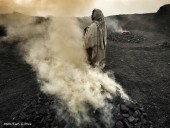Letter from Richard Fuller
In 1999, I founded Blacksmith Institute in New York — the result of an eventful decade of my life and a desire to make an impact on the world. At the time, very little was known about pollution in low- and middle-income countries. Indeed part of the impetus for the organization was a simple chart on a white board; four quadrants, “West” and “South” written down the Y axis, “Green” and “Brown” across the top.
West and South referred, roughly, to hemispheres; Brown and Green to environmental agendas. The chart was part of a series of retreats of sorts that I hosted at my home for like-minded people. The goal of the retreats was to identify the most underserved area in the environmental movement and determine a way to address that gap. In each quadrant, we listed organizations that worked in that area — World Wildlife Federation, Conservation International, Save the Whales — all impressive organizations engaged in powerful, transformative work.
When we were done filling in the names of every organization we could think of, we looked back at the board. Staring back at us was the bottom right quadrant: Brown/ South. We could think of no organization, government or otherwise working in this area. I drew a big “X” in the quadrant and wrapped my knuckles on the board. “This space has a big fat zero. We’ll make our impact here.”
Since that fateful series of retreats at my home, much has changed about our organization. Rather than being run by volunteers, we now have dozens of paid professionals working out of offices in New York, London, New Delhi, Jakarta, and many other cities around the world. We have developed an impressive portfolio of projects, impacting the lives of millions of people. We have changed our name to the more descriptive Pure Earth. And importantly, we have helped identify and single out a silent killer, pollution. Indeed, we now know that pollution accounts for 1 in every 7 deaths in low- and middle-income countries.
Each year, with our partner Green Cross Switzerland, we release a report on pollution and health. This series, “The World’s Worst Pollution Problems,” has been reported on widely from the New York Times to National Geographic and the Times of India. It has been downloaded thousands of times from our servers. In this way, it has made a significant impact on the public’s awareness of the issue.
This year we report on six pollutants that pose an outsized threat to human health. The pollutants — Lead, Radionuclides, Mercury, Hexavalent Chromium, Pesticides and Cadmium — collectively affect the health of 95 million people and account for 14.7 million Disability Adjusted Life Years in low and middle income countries. These pollutants result in debilitating, life-threatening diseases, particularly in children.
We also report on some important advances in the pollution management area. The World Bank has launched the Pollution Management and Environmental Health program (PMEH) to focus on water, air and soil pollution. We expect to see some good results here. Elsewhere, UNEP has spearheaded the Minamata Convention on Mercury. The convention will prohibit new mercury mines and phase out existing mines by signatory countries. Finally, The Global Alliance on Health and Pollution (GAHP) has formed a special Commission on this issue. We report on this progress in special sections in the report.
We hope you find this document useful and informative. We also hope you’ll join us in working on this important issue.
Sincerely,
Richard Fuller
President, Pure Earth
Co-chair, Global Commission on Pollution Health & Development





